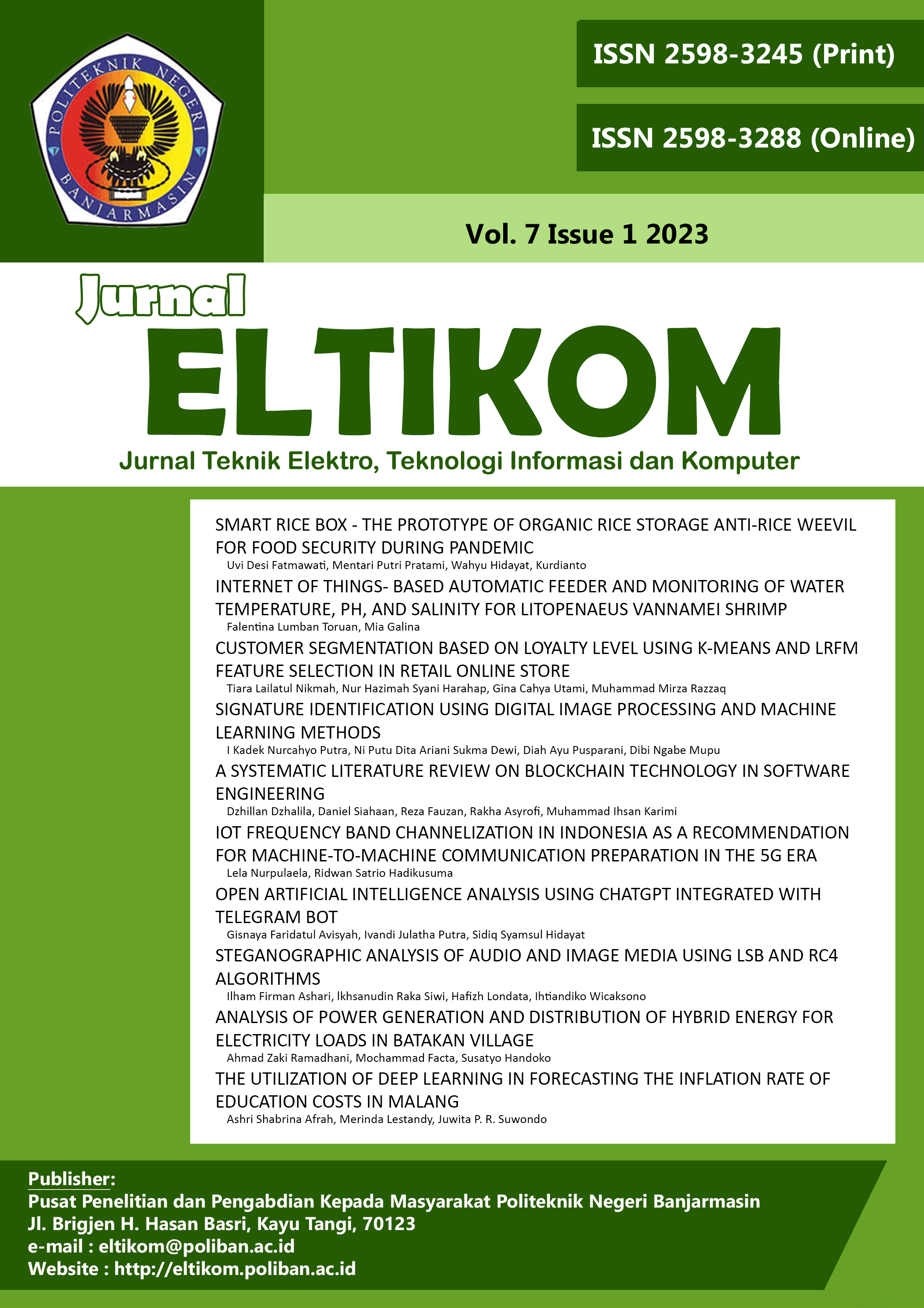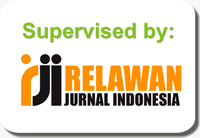Open Artificial Intelligence Analysis using ChatGPT Integrated with Telegram Bot
DOI:
https://doi.org/10.31961/eltikom.v7i1.724Keywords:
API, Artificial Intelligence, Bot Telegram, ChatGPT, Open Artificial IntelligenceAbstract
Chatbot technology uses natural language processing with artificial intelligence that can interact quickly in answering a question and producing relevant answer. ChatGPT is the latest chatbot platform developed by Open AI which allows users to interact with text-based engines. This platform uses the GPT-3 (Generative Pre-trained Transformer) algorithm to help understand the response humans want and generate relevant responses. Using the platform, users can find answers to their questions quickly and relevantly. The method used for OpenAI's research on ChatGPT integrated through Telegram chatbot is using a waterfall method which utilizes open API tokens from Telegram. In this research we develop OpenAI application connected with telegram bot. This application can help provide a wide range of information, especially information related to the Semarang State Polytechnic. By using Telegram chatbot in the program, users can find it easy to ask because it is integrated with OpenAI using the API. Telegram chatbot, which has a chat feature, allows easy communication between users and chatbots. Thus, it may reduce system errors on the bot.
Downloads
References
I. Fauzan, “Artificial Intelligence (AI) Pada Proses Pengawasan dan Pengendalian Kepegawaian - Sebuah Eksplorasi Konsep Setelah Masa Pandemi Berakhir,†J. Civ. Serv., vol. 14, no. 1, pp. 31–42, 2020.
Guntoro, L. Costaner, and Lisnawita, “Aplikasi Chatbot untuk Layanan Informasi dan Akademik Kampus Berbasis Artificial Intelligence Markup Language (AIML),†Digit. Zo. J. Teknol. Inf. dan Komun., vol. 11, no. 2, pp. 291–300, 2020, doi: 10.31849/digitalzone.v11i2.5049.
A. R. Taufani and H. A. Rosyid, “Sistem Tutorial Berbasis Kecerdasan Buatan Pada Proses Pengambilan Keputusan Perawatan dan Perbaikan Gitar,†J. RESTI (Rekayasa Sist. dan Teknol. Informasi), vol. 3, no. 1, pp. 79–86, 2019, [Online]. Available: http://www.jurnal.iaii.or.id/index.php/RESTI/article/view/842
X. Liu, “Artificial intelligence and modern sports education technology,†Proc. - 2010 Int. Conf. Artif. Intell. Educ. ICAIE 2010, pp. 772–776, 2010, doi: 10.1109/ICAIE.2010.5641441.
X. Xu, H. Li, W. Xu, Z. Liu, L. Yao, and F. Dai, “Artificial intelligence for edge service optimization in Internet of Vehicles: A survey,†Tsinghua Sci. Technol., vol. 27, no. 2, pp. 270–287, 2022, doi: 10.26599/TST.2020.9010025.
F. Fourati and M.-S. Alouini, “Artificial intelligence for satellite communication: A review,†Intell. Converg. Networks, vol. 2, no. 3, pp. 213–243, 2021, doi: 10.23919/icn.2021.0015.
E. Nila and I. Afrianto, “Rancang Bangun Aplikasi Chatbot Informasi Objek Wisata Kota Bandung Dengan Pendekatan Natural Language Processing,†Komputa J. Ilm. Komput. dan Inform., vol. 4, no. 1, pp. 49–54, 2015, doi: 10.34010/komputa.v4i1.2410.
P. Dewonoto Laut Santoso, I. Riski, N. Kholik, M. Raffi Akbar, and A. Saifudin, “Penerapan Artificial Intelligence dalam Aplikasi Chatbot sebagai Media Informasi dan Pembelajaran mengenai Kebudayaan Bangsa,†J. Inform. Univ. Pamulang, vol. 6, no. 3, pp. 579–589, 2021, [Online]. Available: http://openjournal.unpam.ac.id/index.php/informatika579
Muliyono, “Identifikasi Chatbot dalam Meningkatkan Pelayanan Online Menggunakan Metode Natural Language Processing,†J. Inform. Ekon. Bisnis, vol. 3, pp. 142–147, 2021, doi: 10.37034/infeb.v3i4.102.
D. Rahayu, M. Mukrodin, and R. Hariyono, “Penerapan Artificial Intelligence Dalam Aplikasi Chatbot Sebagai Helpdesk Objek Wisata Dengan Permodelan Simple Reflex-Agent (Studi Kasus : Desa Karangbenda),†Smart Comp Jurnalnya Orang Pint. Komput., vol. 9, no. 1, pp. 7–21, 2020, doi: 10.30591/smartcomp.v9i1.1813.
C. A. Oktavia, “Implementasi Chatbot Menggunakan Dialogflow dan Messenger Untuk Layanan Customer Service Pada E-Commerce,†J I M P - J. Inform. Merdeka Pasuruan, vol. 4, no. 3, pp. 36–40, 2020, doi: 10.37438/jimp.v4i3.230.
Y. S. Wijaya, Rahmaddeni, and F. Zoromi, “Chatbot Designing Information Service for New Student Registration Based on AIML and Machine Learning,†JAIA-Journal Artif. Intell. Appl., vol. 1, no. 1, pp. 1–10, 2020.
M. U. Fahri, “Implementasi Channel Bot Telegram (Real Time) COVID-19 di Kalimantan Barat dengan Memanfaatkan API,†J. Ilmu Komput. dan Desain Komun. Vis., vol. 5, no. 2, pp. 77–84, 2020.
A. Suparno, “Chat Bot sebagai Implementasi Pemanfaatan Teknologi Artificial Intelligence dengan Channel Telegram,†J. Media Apl., vol. 12, no. 2, pp. 47–55, 2020.
A. Gilson et al., “How Does ChatGPT Perform on the United States Medical Licensing Examination? The Implications of Large Language Models for Medical Education and Knowledge Assessment,†JMIR Med. Educ., vol. 9, pp. 1–9, 2023, doi: 10.2196/45312.
M. I. Kurniawan, U. Sunarya, and R. Tulloh, “Internet of Things : Sistem Keamanan Rumah berbasis Raspberry Pi dan Telegram Messenger,†ELKOMIKA J. Tek. Energi Elektr. Tek. Telekomun. Tek. Elektron., vol. 6, no. 1, p. 1, 2018, doi: 10.26760/elkomika.v6i1.1.
H. Supriyono, F. Suryawan, R. M. A. Bastomi, and U. Bimantoro, “Sistem Monitoring Suhu dan Gas Amonia untuk Kandang Ayam Skala Kecil,†ELKOMIKA J. Tek. Energi Elektr. Tek. Telekomun. Tek. Elektron., vol. 9, no. 3, p. 562, 2021, doi: 10.26760/elkomika.v9i3.562.
H. K. Astuti and N. D. Kuswytasari, “Efektifitas Pertumbuhan Jamur Tiram Putih (Pleurotus ostreatus) dengan Variasi Media Kayu Sengon (Paraserianthes falcataria) dan Sabut Kelapa (Cocos nucifera),†J. Sains dan Seni Pomits, vol. 2, no. 2, pp. 144–148, 2013.
A. D. Mulyanto, “Pemanfaatan Bot Telegram Untuk Media Informasi Penelitian,†J. Ilmu Komput. dan Teknol. Inf., vol. 12, no. 1, p. 49, 2020, doi: 10.18860/mat.v12i1.8847.
N. Triwahyuni and S. Beta, “Running Text Information System Design Internet-Based for Small Outlets,†J. Appl. Inf. Commun. Technol., vol. 7, no. 2, p. 2022, 2022.
H. A. Bukhori, B. Rahayudi, and W. H. N. Putra, “Optimasi Business Process Improvement Berbantuan Metode FLASH dengan Integrasi API Trello,†J. RESTI (Rekayasa Sist. dan Teknol. Informasi), vol. 1, no. 1, pp. 19–25, 2017.
D. Nataliana, I. Syamsu, and G. Giantara, “Sistem Monitoring Parkir Mobil menggunakan Sensor Infrared berbasis RASPBERRY PI,†ELKOMIKA J. Tek. Energi Elektr. Tek. Telekomun. Tek. Elektron., vol. 2, no. 1, p. 68, 2014, doi: 10.26760/elkomika.v2i1.68.
R. A. Khan, S. U. Khan, H. U. Khan, and M. Ilyas, “Systematic Literature Review on Security Risks and its Practices in Secure Software Development,†IEEE Access, vol. 10, pp. 5456–5481, 2022, doi: 10.1109/ACCESS.2022.3140181.
D. Saptono, T. M. Sampurna, and T. W. R. N, “Implementasi Algoritma Gunning Fog Index Pada Uji Keterbacaan ( Readability Test ) Bahasa Indonesia Menggunakan Bahasa Pemrograman Python,†vol. 2013, no. November, 2013.
Martanto, R. D. Wihadi, R. D. Agusulistyo, and Tjendro, “Penampil Gelombang Tegangan dan Arus Berbasis Arduino Due untuk Generator AC Tiga Fasa,†ELKOMIKA J. Tek. Energi Elektr. Tek. Telekomun. Tek. Elektron., vol. 8, no. 2, p. 336, 2020, doi: 10.26760/elkomika.v8i2.336.
S. A. Sena, A. Muttaqin, and A. Setyawan, “Perancangan dan Pembuatan Application Interface Server untuk Arduino,†J. Tek. Elektro, Fak. Tek. Univ. Brawijaya, vol. 1, no. 4, pp. 1–6, 2013.
Downloads
Published
How to Cite
Issue
Section
License
Copyright (c) 2023 Jurnal ELTIKOM : Jurnal Teknik Elektro, Teknologi Informasi dan Komputer

This work is licensed under a Creative Commons Attribution-NoDerivatives 4.0 International License.
All accepted papers will be published under a Creative Commons Attribution 4.0 International (CC BY 4.0) License. Authors retain copyright and grant the journal right of first publication. CC-BY Licenced means lets others to Share (copy and redistribute the material in any medium or format) and Adapt (remix, transform, and build upon the material for any purpose, even commercially).




